Product Requirements:
A PDA that measures under 5.5" long x
3.5" wide x 0.9" deep
When I reviewed the OtterBox
Armor 3600
back in 2003, there was no doubt in my mind that I had just discovered the "Humvee
of PDA Protection." No case I had seen, or that I have since seen, has even come
close to offering delicate electronics such perfect protection when they
are used in abnormally harsh conditions.
However, this solution was aimed more at larger sized PDAs, such as the
HP iPAQ 5455,
which I used for testing at the time. Those with shorter or more shallow devices
would have found the Armor 3600 to be a bit of oversized overkill, though I am
sure that there were some who went ahead and used one anyway, out of necessity.
Now OtterBox is offering a rugged solution for the more compact PDAs and the
people that use them in extreme conditions, the
Armor 1900.

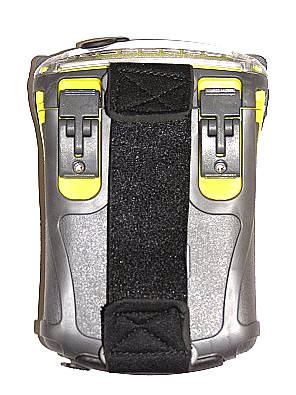

Like the 3600 model previously reviewed, the Armor 1900 is not a case for
those that only need to add a bit of screen protection to their PDA. It is for
people who have to cope with the harshest conditions that can be thrown at them,
as they are using their electronic device.
The OtterBox site lists the features of the Armor 1900 as:
To begin, the Armor 1900 has a very rugged appearance. Available in either
Midnight Black and Fluorescent Yellow and accented with gray, this case has an
abundance of latches, sealed ports and usable features.
Lets take a look and see if the 1900 lives up to its predecessor…
Universal fit for smaller form factor PDAs:
The Armor 1900 measures 6.57" (16.7cm) tall x 4.64" (11.8cm) wide x 2.2"
(5.6cm) thick at it’s largest points. Its interior is shaped so that it can hold
a device measuring no more than 5.6" (14.1cm) tall x 3.5" (9cm) wide x 0.9"
(2.4cm) deep.
Instead of using a series of removable pads to push the PDA to the front of
the case, the Armor 1900 uses a clever Velcro strap suspension system which
keeps the PDA tightly held next to the replaceable write-through membrane and
it’s plastic border.


Flexible, fully sealed
interactive screen membrane:


The membrane is a thin sheet of clear flexible
plastic. You can write on it directly with a PDA stylus. As long as you don’t
write so heavily that you gouge holes into the membrane, it will remain
waterproof. Over time, this membrane will probably show wear, and when that
happens replacements can be
ordered.
The interior of the case is composed of unlined plastic, but since the PDA
should not really touch anything but the screen membrane, its plastic border and
the Velcro suspension system, it is unlikely that the PDA will become scratched
while in the case.
As you might have guessed by the case’s name, the
HP iPAQ 1900
series perfectly fits…
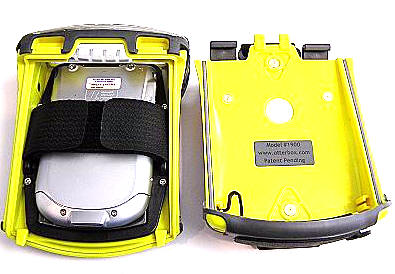
A flip-up cover protects the touch screen when it is not being written upon.
Flip-up hard screen cover:
As mentioned, the screen of the PDA is protected by a
clear plastic flip-lid. This cover will swing approximately 180º,
either in the down and fully closed position, or standing straight up. I was
pleasantly surprised to find that the lid would more or less stay up on its own
when flipped to the upward position, but I suspect that over time it will not
keep the same tension. Missing is the more secure closure system that the Armor
3600 utilized. By this, I mean that the flip lid is not held securely shut when
it is in the down position, it can be easily raised..

Waterproof, crushproof,
drop-proof ergonomic design:
Here you can see it in our hot tub. So yes, I would
call it waterproof and the Armor 1900 also floats.

According to the OtterBox website, "All OtterBox cases
– from the original OtterBox case to the innovative Armor 3600 for PDA
protection — feature a closed-cell neoprene o-ring that seals out water – no
matter how harsh the conditions. Independent tests show OtterBox cases keep
valuables dry to depths of 110 feet – even in chilly Alaskan waters."
The case is crushproof in the sense that heavy items
will not cause it to collapse upon the PDA. I tested this by once again
convincing Steve to balance his 200 pounds on the screen cover of the case.
However, the Armor 1900 is so much smaller than the 3600 previously tested that
he wasn’t able to put both feet on it…

I didn’t care to drive over the case or put it under what might be
considered a truly destructive crushing weight, but for those of you that
want to know if the Armor 1900 can take that kind of abuse, there is a picture
of an Otterbox under a Jeep’s wheel on their website…

photo courtesy of OtterBox
Drop proof? Yes, and for two reasons…
Adjustable neoprene hand strap:
First, because if you are using the strap attached to
the back of the case there is virtually no chance that you will drop the
enclosed PDA. The hand strap is made of thick stretchy neoprene with adjustable
Velcro ends that fold back upon themselves for a perfect fit. When using the
strap, the case is securely held in the user’s hand, with virtually no chance of
being dropped.

Of course, if the user needs a more hands-free way to
carry the case, there is also an optional neck lanyard kit.
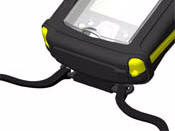
photo courtesy of OtterBox
The second reason that the case is drop-proof is
because if the user happens to be a total klutz (like me), the case will survive
a long fall onto concrete without the PDA inside getting damaged. Yes, I did try
that test out multiple times (on purpose) from about a height of 4′ onto
a wooden floor. The PDA and case survived in fine shape, though on about the
fifth drop the flip lid did pop off..
Quick access to CF and SD slots
through the top of the case:
The entire clear top of the Armor 1900 can be opened
to allow direct access to the SD or CF card slots at the top of the PDA.
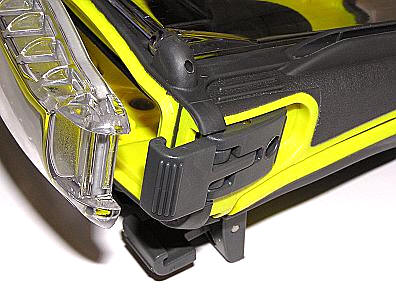
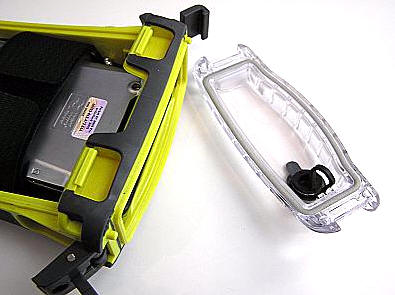
There are even different sized PODs available that can
accept taller GPS cards or scanning modules that may need to be added to the
PDA.



From left to right: large POD, medium POD, and the Scanner POD
with a hardened scratch-resistant lens, photos courtesy of OtterBox
The only area where you might find that there is limited to non-existent
accessibility is in regard to the voice record button and the Infrared port. On
the iPAQ 1945, these are both located on the left side, which is of course
covered by the hard case. The record button can be re-mapped if you need it, but
there is no way around the placement of the Infrared port – you’ll just have to
do without using it when the PDA is in the Armor 1900. I hardly ever even use my
IR port, so it’s not that big of a deal to me.
Headphone/headset access:
There is a rubber plug on the left side that a headset
cord can be threaded through. Once the cord is through and the plug has been
replaced, the PDA is once again safe from water, dust and dirt.

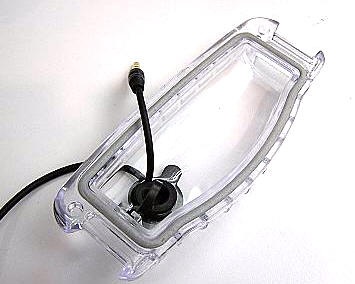
Note the rubber gaskets that are present on all of the removable pieces of
the case. These are a major line of defense against dust, dirt and water. They
should always be kept clean and periodically inspected for deterioration.
Quick access to PDA connection
through the bottom of the case:
Unlike other ruggedized cases that require the removal
of the PDA for syncing or charging, the Armor 1900 has a large rubber plug that
pops off the bottom to allow direct access to the port.


There is even a serial port connection that can be
added to the bottom of newer model iPAQs that share the standard 22 pin bottom
connector.

photo courtesy of OtterBox
External stylus holder:
The left side of the case has a molded rubber stylus
holder, which will keep the use from having to keep one stowed in their pocket.
This also allows the user to use a slightly thicker stylus than the one that
fits in their PDA’s silo.
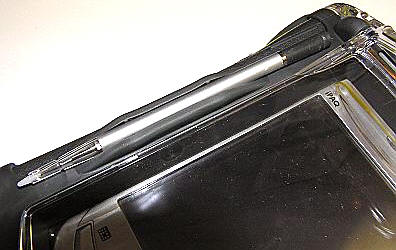
Easy open compound latch system:
The latches found on the back of the case and on the top are all heavy duty
plastic that requires pieces about to be held together to be fitted in correctly
– creating a seal. Then the latches are clamped down and locked. These latches
are stiff, and will not come undone unintentionally, yet they are easy enough to
operate when access is needed.



Each latch has a hole in it’s stem so that you can lock it down with the
included hex screws and allen wrench.


An extra rubber plug for the headset hole is also included.
Gore membrane vent:
Inside the case’s back wall is a covered vent. I assume (always dangerous)
that this is to help keep condensation from appearing on the screen of the PDA
when it is moved from one temperature extreme to the next.

Fully expandable for all accessories:
There are any number of
accessories
available for the Armor 1900 that will make it even more adaptable to any use
that someone can dream up. Items like belt clips, the preciously mentioned
larger GPS or scanner pods that attach to the top, neck lanyards, a serial port
adapter, as well as various vehicle mounting solutions are available. It would
be very easy to spend twice the amount of the case adding accessories, but the
ability to do so makes this case all the more valuable.
One benefit of a case like this is that instead of spending big money
on a ruggedized PDA that will most likely be running an older OS or worse – not
have a color screen, the end user can instead instantly ruggedize any PDA that
they already own, or will eventually buy, simply by placing it in this case.
Unconditional lifetime guarantee:
According to the OtterBox site, "If your OtterBox product fails for any
reason, call us at 888-695-8820 and we’ll gladly replace it. We stand behind our
cases 100%."
Once again, I think that OtterBox has set the standard for ruggedized PDA
cases. I believe that the Armor 1900 lives up to every one of its claims,
and I doubt that there is a better PDA case available for people that need
ultimate protection either because of their jobs or their pastimes. If you are
the type of person that have a typical job in a sterilized environment, and you
need a case that can protect your PDA from a herd of elephants or a sudden
squall and you have a smaller PDA, then the
OtterBox Armor
1900 is the case for you. Don’t forget that if you have a larger device and
you need the ultimate in protection, you can always get the
Armor 3600.
Price: $99.95
Available in black or yellow
Pros:
Rugged, waterproof/dustproof/crushproof protection for your PDA
Many accessories to make case work for your unique needs
Easy access to most ports on the PDA
Cons:
No access to Infrared port
It’s big and expensive – but if you need it, that won’t stop you
Breloom SH6 Handheld Terminal, Windows 11 Pro, Intel N100, 8GB+256GB, 6.5" Rugged Data Terminal PDA, 4G LTE/GPS/WiFi 6/BT 5.2, 5000mAh Battery (SH6)
$539.99 (as of November 3, 2025 11:17 GMT -05:00 - More infoProduct prices and availability are accurate as of the date/time indicated and are subject to change. Any price and availability information displayed on [relevant Amazon Site(s), as applicable] at the time of purchase will apply to the purchase of this product.)Microsoft Surface Pro 3 (128 GB, Intel Core i5) (Renewed)
Product Information
| Price: | 99.95 |
| Manufacturer: | OtterBox |
| Pros: |
|
| Cons: |
|



Gadgeteer Comment Policy - Please read before commenting
On PalmOS PDAs, the IR port is at the top. I understand it would work with this case. It sounds perfect for my cave survey freeware 🙂